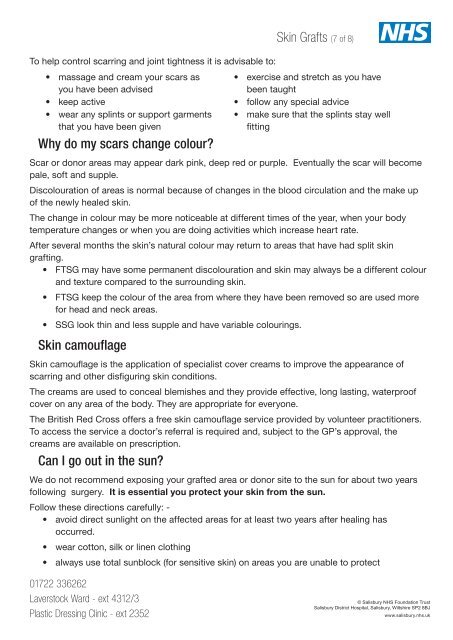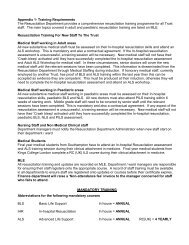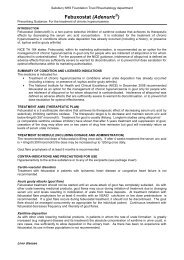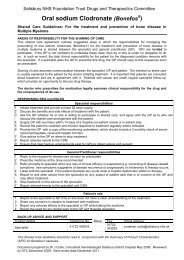Skin Grafts - ICID - Salisbury NHS Foundation Trust
Skin Grafts - ICID - Salisbury NHS Foundation Trust
Skin Grafts - ICID - Salisbury NHS Foundation Trust
Create successful ePaper yourself
Turn your PDF publications into a flip-book with our unique Google optimized e-Paper software.
To help control scarring and joint tightness it is advisable to:<br />
<strong>Skin</strong> <strong>Grafts</strong> (7 of 8)<br />
• massage and cream your scars as • exercise and stretch as you have<br />
you have been advised<br />
been taught<br />
• keep active<br />
• follow any special advice<br />
• wear any splints or support garments • make sure that the splints stay well<br />
that you have been given<br />
fitting<br />
Why do my scars change colour?<br />
Scar or donor areas may appear dark pink, deep red or purple. Eventually the scar will become<br />
pale, soft and supple.<br />
Discolouration of areas is normal because of changes in the blood circulation and the make up<br />
of the newly healed skin.<br />
The change in colour may be more noticeable at different times of the year, when your body<br />
temperature changes or when you are doing activities which increase heart rate.<br />
After several months the skin’s natural colour may return to areas that have had split skin<br />
grafting.<br />
• FTSG may have some permanent discolouration and skin may always be a different colour<br />
and texture compared to the surrounding skin.<br />
• FTSG keep the colour of the area from where they have been removed so are used more<br />
for head and neck areas.<br />
• SSG look thin and less supple and have variable colourings.<br />
<strong>Skin</strong> camouflage<br />
<strong>Skin</strong> camouflage is the application of specialist cover creams to improve the appearance of<br />
scarring and other disfiguring skin conditions.<br />
The creams are used to conceal blemishes and they provide effective, long lasting, waterproof<br />
cover on any area of the body. They are appropriate for everyone.<br />
The British Red Cross offers a free skin camouflage service provided by volunteer practitioners.<br />
To access the service a doctor’s referral is required and, subject to the GP’s approval, the<br />
creams are available on prescription.<br />
Can I go out in the sun?<br />
We do not recommend exposing your grafted area or donor site to the sun for about two years<br />
following surgery. It is essential you protect your skin from the sun.<br />
Follow these directions carefully: -<br />
• avoid direct sunlight on the affected areas for at least two years after healing has<br />
occurred.<br />
• wear cotton, silk or linen clothing<br />
• always use total sunblock (for sensitive skin) on areas you are unable to protect<br />
01722 336262<br />
Laverstock Ward - ext 4312/3<br />
Plastic Dressing Clinic - ext 2352<br />
© <strong>Salisbury</strong> <strong>NHS</strong> <strong>Foundation</strong> <strong>Trust</strong><br />
<strong>Salisbury</strong> District Hospital, <strong>Salisbury</strong>, Wiltshire SP2 8BJ<br />
www.salisbury.nhs.uk

















